Towards solid timber production from Eucalyptus nitens
Dean Satchell, New Zealand Tree Grower August 2015.
Eucalyptus nitens is a cold hardy hardwood timber species with very fast growth and excellent form.
In Canterbury, along with other cooler regions in New Zealand, E. nitens produces high volumes of sawlog sized material in relatively short rotations. Some farm foresters have even pruned their trees in anticipation of sawn timber production. The purpose of this case study was to assess the profitability of growing E. nitens for sawn timber production from 15-year-old trees that were planted, pruned and thinned by farm forester Patrick Milne near Rangiora, Canterbury. The stand contained 55 trees from which a sample of 8 trees (32 logs) were harvested and milled to examine costs and revenues. Physical properties were also assessed from these young fast-grown trees and compared with imported Victorian ash.
The need for a case study
Currently in Canterbury the only market option for E. nitens logs is firewood. Logs on average gross $50 per tonne delivered, from which harvesting and transport costs are deducted for a net return to the grower of between $0 and $20 per tonne. Although E. nitens is the preferred species in New Zealand for short-fibre pulpwood, there is no pulpwood industry in Canterbury and thus no market.
At age 15 this stand had a stocking of approximately 470 stems per hectare, with all trees pruned to 6.5 m and an average dbh of 43 cm. The average buttlog diameter was therefore within the optimal range for sawmilling on Woodmizer bandsaw machinery.
The experience from New Zealand processors who have attempted to produce sawn timber is that the species is generally too difficult to saw and dry, primarily because of excessive degrade in drying. This has been confirmed by contemporary Australian research. Consequently there is no current demand for sawlogs and sawn timber is not available in the market, despitte the phenomenal productivity of the species.
E. nitens timber is sufficiently hard for flooring. It is strong and has an attractive appearance. These properties offer opportunities to develop structural, flooring and appearance markets for the timber if the processing challenges could be overcome.

Returns to the grower

In order to estimate returns to the grower, both log volumes per hectare and log prices were required. Log volumes were estimated from two plots in the case study stand, but because there was no market from which to derive price data, estimating log values was more challenging. The residual value approach offered a method commonly used for appraising log values whereby processing costs and required profits are deducted from revenue to leave an estimate of the residual log value.
The market survey produced wholesale prices for each case study board based on its width, length and grade, and according to the physical and appearance characteristics of the 15-year-old case study E. nitens timber. Price estimates for boards were summed for an estimate of revenue from each log.
This case study focussed on production of flooring products. Because market prices for E. nitens timber products were not available, a market survey of merchants, retailers and floor layers was undertaken to establish wholesale price estimates for sawn timber products.
The case study sawmill was John Fairweather's small commercial operation near Balcairn in Canterbury, with a Woodmizer LT 40 super hydraulic bandsaw and Woodmizer twin-blade edger. Other equipment included a drying shed, a Solarola solar kiln and a Logosol 4 side profiler. This equipment has been specifically set up for small scale eucalypt processing.
Estimating profitability
The volumes, sizes and quantities of sawlogs (3m long with diameters greater than 25 cm SED) per hectare were estimated from two plots in the case study stand. Average sawlog small end diameters were estimated to be 33 cm, with 311 tonnes of pruned buttlogs and 208 tonnes of unpruned headlogs at age 15.
There is no question E. nitens is very productive on the right site, but the key to profitability was the level of degrade revealed in the processed sawn timber products. The costs incurred in producing the sawn product and the volume of sawn product recovered also influenced profitability for the case study stand.

Sawn production
Headlogs produced 43% of sawn timber from sample trees, while buttlogs produced 57% of sawn timber. Nominal recovery of sawn timber averaged approximately 40% of log volume. Product recoveries were approximately 85% of sawn timber volume, with collapse and end splits the primary defects present in the sawn timber. End splits amounted to 3.6% of sawn timber; skip caused by excessive collapse was approximately 5% of sawn timber; defect docked because of excessive checking averaged 2.5% of sawn timber; and 3.7% of sawn timber was docked because of knots. In total, 15% of sawn timber was docked because of defect.
Products, costs and price estimates
Approximately 70% of sawn timber was flooring product. Clears/select grade flooring product in lengths greater than 1.2 m was 50% of sawn timber. Boards narrower than 100 mm were priced as panel laminating product, approximately 15% of sawn timber.
Sawmill costs were $90 per hour of operation and averaged $213 per nominal sawn cubic metre of production.
Drying costs per nominal sawn cubic metre were estimated to be $202 and steam-reconditioning costs were an additional $30.
Machining costs per nominal sawn cubic metre were estimated to be $201.
Processing costs averaged $722 per nominal sawn cubic metre, including an 'overhead' cost for administration and management of $98. Total processing costs were $624 per nominal sawn cubic metre before accounting for sawmill overheads.
The wholesale price for profiled flooring product averaged $3.94 for select/clears grade 125 mm width boards greater than 1.2 m length. All boards from the sample logs were docked where necessary, then allocated into grade, width and length categories. Discounts and premiums were then applied to the levels of these categories. Revenues were then estimated for each log by summing prices for the products derived from that log.
Revenue
The average wholesale price for sawn timber was estimated to be $985 per nominal sawn cubic metre. Predicted nominal sawn timber volume produced per hectare was 221 cubic metres and sawn timber revenues were estimated to be $217,610 per hectare, from which log harvesting and transport costs of $23,530 and processing costs of $159,658 were deducted.
Other products added $24,484 to revenue, primarily firewood ($17,950) as a by-product of the sawmill operation. Pulp logs contributed only $993 per hectare from 24.1% of merchantable log volume. After accounting for costs of production, log residual value was approximately $68,320 per hectare.
Sawlog price as stumpage averaged $131 per log cubic metre. Average sawn timber value per log cubic metre was $419.
Discounted cash flows
The base scenario assumed a discount rate of 8.5%, a land price of $10,000 per hectare, logging, loading and transport costs of $44 per tonne and grower costs of $7,507 per hectare. Under this scenario, assuming sawn timber was sold at year 16, net present value (NPV) for the grower was -$260 per hectare. Therefore rate of return for the grower was estimated to be close to 8.5% per annum.
The case study stand was on land not normally planted in forest and because of lifestyle values land price was high. Clearly if growers were to utilise equally productive land that was less expensive then profitability would improve. A sensitivity analysis compared the impact land prices had on profitability along with varying logging and transport costs. By reducing land price to $5,000 per hectare NPV increased to $3,269 per hectare. However, a corresponding increase in logging and transport costs to $77 per tonne significantly reduced NPV to -$6,494 per hectare.
Conclusions
This case study indicates that E. nitens may be an economically viable plantation option for sawlog production. E. nitens is very easy to grow on the right site, produces large volumes of sawlogs on a relatively short rotation and has the potential to be processed into products of sufficient quality and value to produce a profit to the grower.
The benchmark set by this case study is not high. Although attention to applying best-practice processing methods is essential, there is no doubt that improvements will be made to grade recoveries as more is learnt about processing the species. Furthermore, increasing the scale of the plantation resource would result in processing scale efficiencies that in theory would improve returns to the grower. In practice, developing a resource of pruned and thinned E. nitens for solid timber production will no doubt have its challenges, but for the small grower having some confidence that ones endeavours might actually lead to success is surely half the battle won.
The full report ‘Eucalyptus nitens, recovery and economics of processing 15 year old trees for solid timber’ can be viewed on the NZFFA website.
Thanks and acknowledgement for this project go to −
- MPI Sustainable Farming Fund
- Neil Barr Farm Forestry Foundation
- John Fairweather Specialty Timbers
- North Canterbury, South Canterbury, South Otago and Southland branches of NZFFA
- NZFFA Eucalyptus Action Group
- NZFFA Research committee.

 Farm Forestry New Zealand
Farm Forestry New Zealand
No posts yet
Add a post